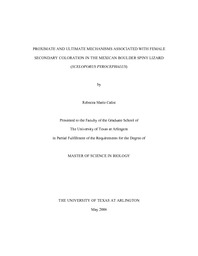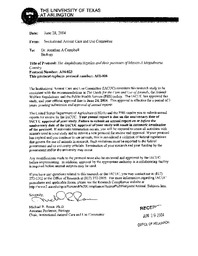
ATTENTION: The works hosted here are being migrated to a new repository that will consolidate resources, improve discoverability, and better show UTA's research impact on the global community. We will update authors as the migration progresses. Please see MavMatrix for more information.
Show simple item record
| dc.contributor.author | Calisi, Rebecca Marie | en_US |
| dc.date.accessioned | 2007-08-23T01:56:37Z | |
| dc.date.available | 2007-08-23T01:56:37Z | |
| dc.date.issued | 2007-08-23T01:56:37Z | |
| dc.date.submitted | May 2006 | en_US |
| dc.identifier.other | DISS-1254 | en_US |
| dc.identifier.uri | http://hdl.handle.net/10106/400 | |
| dc.description.abstract | Secondary sexual coloration is thought to be the result of runaway selection for signals that honestly communicate relative fitness. Much theoretical work suggests sexual selection has driven conspicuous secondary traits in males while natural selection has driven inconspicuous traits in females; however, in some species, bright female secondary coloration does exist. I used the Mexican boulder spiny lizard (Sceloporus pyrocephalus) as a model to examine secondary coloration in females. Adult females of S. pyrocephalus have conspicuously colored gular regions, ranging from red, orange, to yellow, while adult males weakly express color in the gular region. Both sexes have dark stripes on the gular and venter areas and display these traits during same- and opposite-sex encounters. I examined sex steroid hormonal concentrations, reproductive state, and nematode abundance as predictors of secondary coloration, and how color can ultimately relate to resource holding potential.
My results suggest that color in females may be under hormonal control. Coloration in females changes with reproductive state, and hormonal changes associated with the female reproductive cycle may control this color change. Nematode loads are related to female color as well as circulating plasma testosterone concentrations; thus, color has the potential to serve as an honest signal of reproductive state and nematode load. Finally, while the ultimate implications of female coloration require additional study, larger areas covered by females with red gular regions and pale gular and venter stripes (color characteristics also indicative of high testosterone, late vitellogenic reproductive stages, and high nematode loads) could lead to the increased acquisition of resources, access to mates, and/or egg depositing sites, which in turn may result in greater fitness benefits. Conversely, these resource benefits may carry a cost of an increased predation risk, energy expenditure, and/or parasite exposure. Females of S. pyrocephalus may experience a tradeoff between sexual selection for secondary coloration and natural selection for survivorship. These results both illuminate and further necessitate new theoretical and empirical studies of female coloration to provide a more inclusive theory of sexual selection. | en_US |
| dc.description.sponsorship | Formanowicz, Daniel | en_US |
| dc.language.iso | EN | en_US |
| dc.publisher | Biology | en_US |
| dc.title | Proximate And Ultimate Mechanisms Associated With Female Secondary Coloration In The Mexican Boulder Spiny Lizard, (Sceloporus pyrocephalus) | en_US |
| dc.type | M.S. | en_US |
| dc.contributor.committeeChair | Formanowicz, Daniel | en_US |
| dc.degree.department | Biology | en_US |
| dc.degree.discipline | Biology | en_US |
| dc.degree.grantor | University of Texas at Arlington | en_US |
| dc.degree.level | masters | en_US |
| dc.degree.name | M.S. | en_US |
| dc.identifier.externalLink | https://www.uta.edu/ra/real/editprofile.php?onlyview=1&pid=77 | |
| dc.identifier.externalLinkDescription | Link to Research Profiles | |
Files in this item
- Name:
- umi-uta-1254.pdf
- Size:
- 892.3Kb
- Format:
- PDF
- Name:
- IACUC_Calisi.pdf
- Size:
- 221.0Kb
- Format:
- PDF
This item appears in the following Collection(s)
Show simple item record



